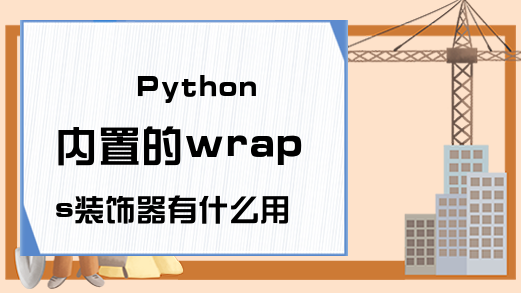Python内置的wraps装饰器有什么用
【摘要】Python装饰器(decorator)在实现的时候,被装饰后的函数其实已经是另外一个函数了(函数名等函数属性会发生改变),为了不影响,Python的f

Python装饰器(decorator)在实现的时候,被装饰后的函数其实已经是另外一个函数了(函数名等函数属性会发生改变),为了不影响,Python的functools包中提供了一个叫wraps的decorator来消除这样的副作用。写一个decorator的时候,最好在实现之前加上functools的wrap,它能保留原有函数的名称和docstring。
wraps内置方法的作用
查看一个函数的帮助文档有两种方法:
func_name.__doc__
help(func_name)先来看一个例子,定义timmer装饰器和index函数,并且都添加了帮助文档。
import time
def timmer(func):
def inner(*args,**kwargs):
'wrapper inner function'
start_time=time.time()
res=func(*args,**kwargs)
end_time=time.time()
print("run time: %s " %(end_time-start_time))
return res
return inner
def index():
'index function'
time.sleep(2)
print("welcome to index page")在index没有被timmer装饰前,来查看index的帮助文档:
print(index.__doc__)程序运行结果:
index function然后为index添加timmer装饰器,再次查看index函数的帮助文档:
import time
def timmer(func):
def inner(*args,**kwargs):
'wrapper inner function'
start_time=time.time()
res=func(*args,**kwargs)
end_time=time.time()
print("run time: %s " %(end_time-start_time))
return res
return inner
@timmer
def index():
'index function'
time.sleep(2)
print("welcome to index page")
print(index.__doc__)程序运行结果:
wrapper inner function可以看到,在为index函数添加装饰器后,index函数的帮助文档变成装饰器timmer内部函数的帮助文档了。
换句话说,就是原始index函数内部的数据被装饰器timmer修改了。
相关推荐:《Python视频教程》
怎么样才能在保留原始被装饰函数的数据的前提下,为函数添加新功能呢??就是python内置的wraps装饰器。
导入wraps装饰器,修改上面的代码,为timmer的内部函数添加wraps装饰器,然后再次查看被装饰函数的帮助文档:
import time
from functools import wraps
def timmer(func):
@wraps(func)
def inner(*args,**kwargs):
'wrapper inner function'
start_time=time.time()
res=func(*args,**kwargs)
end_time=time.time()
print("run time: %s " %(end_time-start_time))
return res
return inner
@timmer
def index():
'index function'
time.sleep(2)
print("welcome to index page")
print(index.__doc__)运行程序,执行结果如下:
index function可以看到,index函数即使添加了装饰器,其内部的原始数据仍然没有被装饰器修改。
从上面的示例可以看出,wraps装饰器的作用就是保留被装饰对象的原始数据信息。
实例一:
不加wraps
# -*- coding=utf-8 -*-
from functools import wraps
def my_decorator(func):
def wrapper(*args, **kwargs):
'''decorator'''
print('Calling decorated function...')
return func(*args, **kwargs)
return wrapper
@my_decorator
def example():
"""Docstring"""
print('Called example function')
print(example.__name__, example.__doc__)执行结果:
('wrapper', 'decorator')实例二:
加wraps
# -*- coding=utf-8 -*-
from functools import wraps
def my_decorator(func):
@wraps(func)
def wrapper(*args, **kwargs):
'''decorator'''
print('Calling decorated function...')
return func(*args, **kwargs)
return wrapper
@my_decorator
def example():
"""Docstring"""
print('Called example function')
print(example.__name__, example.__doc__)执行结果:
('example', 'Docstring')总结:
warps 作用: 消除(被装饰后的函数名等属性的改变)副作用。
相关推荐:
Python之被装饰函数参数的设置与定义
就业培训申请领取


环球青藤
官方QQ群扫描上方二维码或点击一键加群,免费领取大礼包,加群暗号:青藤。 一键加群


刷题看课 APP下载
免费直播 一键购课
代报名等人工服务











